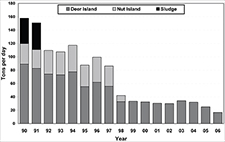BACKGROUND: THE BASICS ABOUT THE MWRA OUTFALL |
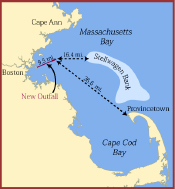
(larger image)
The MWRA Outfall is a 9.5-mile long tunnel that discharges treated wastewater from the Deer Island Treatment Plant into Massachusetts Bay. It began operating in September 2000. |
ABOUT THE NPDES PERMIT |
In preparation for the outfall's start-up, MWRA was legally bound to a very strict National Pollutant Discharge Elimination (NPDES) Permit issued jointly by the US EPA and MA DEP. It went into effect in August 2000 and MWRA continues to adhere to this permit.
The permit requires MWRA to perform and report on two main categories of outfall monitoring: Effluent (the water that is discharged through the outfall) and Ambient (the outfall's receiving waters and dependent wildlife.) |
WHAT IF THERE IS A PROBLEM? |
| The permit specifies how MWRA and regulatory agencies would respond if monitoring results show a possible problem. Whether there is a problem or not, all results are reported to the US EPA, MA DEP and to the public. |
|
MORE INFORMATION |
"Boston Harbor Outfall"
by Bruce Berman
Communications Director,
Save the Harbor/Save the Bay
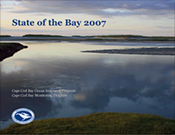
In "State of the Bay 2007" (PDF)
by the Provincetown Center for Coastal Studies
"One of the common concerns that Save the Harbor/Save the Bay shares with organizations like the Provincetown Center for Coastal Studies and other groups from Cape Cod to Cape Ann is that the Boston Harbor clean-up not come at the expense of Massachusetts Bay or Cape Cod Bay.
In the early phases of the project we [STH/STB] were all particularly concerned about the potential impacts of the 9.5 mile long Mass Bay Outfall, which discharges treated effluent into Massachusetts Bay.
To address these concerns, we required strict limits on what could – and could not – be discharged into our marine environment, and began monitoring the site for potential impacts even before the plant went on line.
The results of that monitoring are regularly reviewed by a panel of independent scientists known as the Outfall Monitoring Science Advisory Panel (OMSAP) working in partnership with citizens and organizations around the bay through OMSAP’s Public Interest Advisory Committee, which we chair.
Based on what we have learned so far from the extensive monitoring in place, we are pleased to report that the outfall appears to have had no negative or dramatic impacts on either Massachusetts Bay or Cape Cod Bay. Though there have been glitches from time to time, the monitoring program, the Deer Island sewage treatment facility and the Mass Bay outfall appear to working quite well.
In fact, the area adjacent to the diffusers at the end of the pipe is now home to a rock crab, brown and white sea anemones, and orange or bone white "sea peach" tunicates.
If you would like to attend the next meeting of OMSAP and PIAC scheduled for early December, contact Ben Lasley at SH/SB by email. You can learn more about the outfall and its impacts on the environment at the MWRAWebsite." |
|
MWRA is pleased to report that test results for 2006 show that the Deer Island Treatment Plant continues to operate as designed, and that discharges through the MWRA Outfall had no unexpected effects on the waters or ecosystems of Massachusetts and Cape Cod Bays. In addition, no impacts of the outfall on the Stellwagen Bank National Marine Sanctuary were detected.
Summaries of effluent results and ambient monitoring results follow.
All results for 2006 are presented in detail in MWRA's "2006 Outfall Monitoring Overview." The full report (PDF) is available for download.
2006 HIGHLIGHTS - DEER ISLAND EFFLUENT RESULTS |
MWRA is required to perform stringent and specific tests on the Deer Island Treatment Plant and its effluent (the wastewater that is discharged through the MWRA outfall). Deer Island effluent continuously met water quality standards in 2006. |
SOLIDS REDUCED BY APPROXIMATELY 90% SINCE 1990 |
|
The amount of solids in MWRA effluent remained low. Overall, solids discharge levels have been reduced by approximately 90% since 1990. This indicates that the Deer Island Treatment Plant has been working effectively to remove particulate matter from the wastewater stream. |
METALS DISCHARGES WERE LOWER THAN EVER IN 2006 |
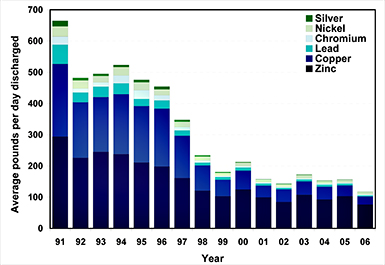
(larger image) |
Metals in effluent remained at low levels, and metals discharges were lower than ever in 2006. Metals entering the plant have been reduced by industrial pre-treatment, and are further removed during secondary treatment so that the effluent meets stringent limits that protect marine life. |
SECONDARY TREATMENT LIMITS CONTINUOUSLY MET |
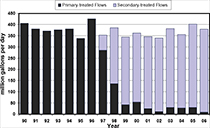
(larger image) |
Deer Island effluent continuously met secondary treatment limits. This indicates that the treatment plant has effectively reduced levels of Total Suspended Solids (TSS) and Carbon Oxygen Demand (cBOD) in wastewater before discharge. |
|
Back to top
2006 HIGHLIGHTS - AMBIENT MONITORING RESULTS |
Researchers test Massachusetts Bay water, sediment and plant/animal communities to ensure that the MWRA Outfall's treated effluent does not adversely impact the ocean or its inhabitants. No adverse impacts to the environment of the bays were detected in 2006. |
ANIMAL COMMUNITIES ARE THRIVING NEAR THE OUTFALL |
|
On the rocks near the outfall, abundant animal communities, including cod, lobster and rock crab, are thriving. Normal communities of worms, anthropods and mollusks live on the sea floor near the outfall. |
RATE OF LIVER DISEASE IN FLOUNDER CONTINUED TO DECLINE |
|
In 2006, the rate of early liver disease in flounder continued to decrease overall in Boston Harbor. There was no increase in liver disease at the MWRA outfall site. |
AN ABUNDANCE OF WHALES IN THE BAYS |
|
Healthy whales continue to live in Massachusetts and Cape Cod Bays. In 2006 the number and diversity of the phytoplankton and zooplankton that whales eat remained normal and typical for the area. |
|
Back to top
# # #
PDF files on this site require Adobe Acrobat Reader® (free download).
|


